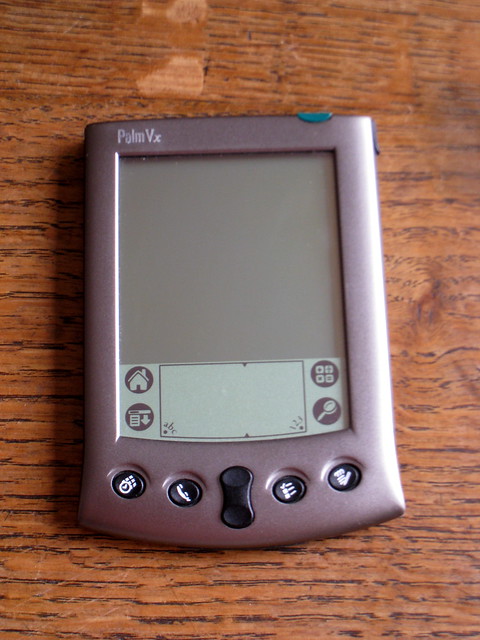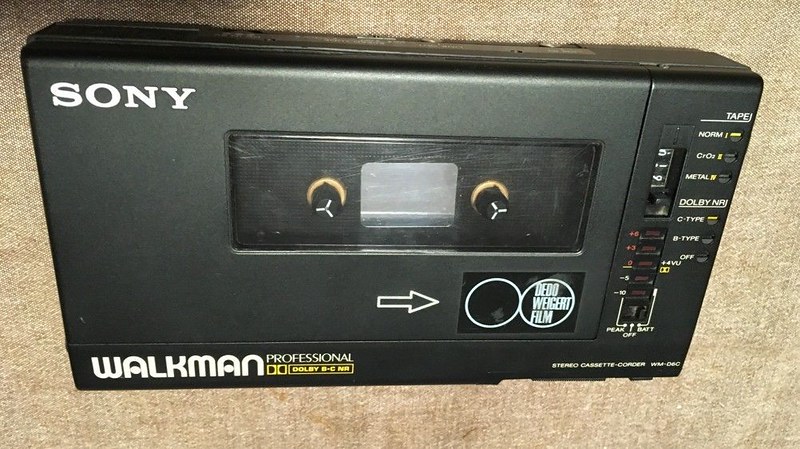When I started agency life I still had a trusty Filofax that had my contacts I had built up from DJing, working in the oil industry and being in college written in barely legible text on address sheets or plastic sheets stuffed with business cards. It had a reassuring heft to it like it contained both the old and new testaments of the bible. In my first 12 months working at the agency, my contacts were further swelled by journalists, suppliers, clients and colleagues stuffed into two Rolodex frames and 99 numbers on the SIM of my then new Ericsson PF 768 mobile phone.In addition to all this, I also had built up a database of over 200 industry contacts on ClarisWorks running on my by now ancient Apple PowerBook. This presented me with the kind of problems that businesses sorted with CRM software. A second problem that I had was making all this data portable. The solution to all this was the Palm Vx.
The only device that was compatiable with my Mac was the Palm series of devices and flush with cash from my first year’s bonus. I got myself a Palm Vx from Expansys. In many respects despite its lack of an always-on wireless connection, the Palm Vx was the benchmark I have in mind when I look at smartphones.
At its core the smartphone lives or dies by its personal information manager and its ability to sync with your computer for your contacts and calendar. When I used a Palm Vx, I never had the machine brick when I loaded too many contacts on to it, it never endlessly duplicated or corrupted contacts and it didn’t freak out when you scheduled events more than three months ahead.
Unfortunately the same can’t be said for subsequent devices I owned including Palm’s Treo 600 and 650 phones, or the succession of Nokia devices I owned up until my E90 communicator gave up the ghost and went to the great Carphone Warehouse in the sky.
The Vx was primitive, which was one of its main strengths:
- Its screen which showed 16 types of grey was easy to view in direct sunlight
- It’s electroluminescent backlight allowed you to view it in a darkened room and still have enough battery left to last you a week
- It didn’t have an app store, but then there wasn’t any productivity sucking software and you could find new applications with your search engine of choice
- It had to use a stylus for all but the most basic items on the resistive touchscreen, but Palm’s original single stroke handwriting called Graffiti once you got the hang of it is faster to use than the soft keyboard on my iPhone. Unfortunately a long-running patent dispute that went on until 2004 meant that Palm had to move to the inferior Graffiti 2 based on a product called Jot
- It did allow you to sync your desktop PC’s inbox with your device so you could go through your email on the commute home, but you wouldn’t be bothered by the always connected aspects of push email. Push technology was a big thing then so if you got tired of clearing out your inbox you could read highlights from Wired.com or CNBC via the AvantGo service which sucked in content via your PC that you could then browse through offline at your leisure; in many respects an RSS reader before RSS became well-known
- Location-based software before GPS was a subscription service called Vindigo that provided recommendations on restaurants, clubs and bars, and shopping. It also had maps that provided turn-by-turn instructions from a look-up table of directions and was updated by syncing via serial port or USB connected cradle
- Wireless connectivity was an IrDA infra-red port which was pathetic. I once tried to use it in conjunction with my Ericsson phone to surf the web but it was too much effort to keep both of them lined up. It was perfectly fine though for exchanging business cards electronically. I remember being at a Red Herring conference during the summer of 2000, demoing Palm devices and spent half the time beaming business cards with consultants and lawyers. It involved a curious ritual akin to an animal courtship display where two people would hold their devices in front of each other and move them closer or apart until their contact details had been exchanged. But it seemed to work better than any solution since. Moo cards are now my common currency of information exchange instead
It was the industrial design of the Palm V and Vx that feels the most prescient parts of the product in many respects. Some of the decisions in this were forced on the designers by the hardware specifications. Palm used to use AAA batteries in their earlier devices and held the OS and resident apps in ROM. ROM was expensive at the time so the V and the Vx had everything in RAM which meant that there always needed to be a power supply which meant they had to use a lithium-ion battery. Since the battery wasn’t designed to be user serviceable the case was hot-glued together. This allowed the industrial designers to make the device much thinner so that it could be slipped into a set of jeans or a shirt pocket and weighed in at a paltry 114g, some 20g lighter than my iPhone without its case.
The need for a ‘picture frame’ around the screen provided the designers with a way of making the device feel nicer in the hand by making it have rounded edges. It wasn’t that far off the iPhone in terms of size, but felt nicer to hold. When I first got my iPhone 3GS the device felt too wide in my hand. The product design encouraged premium brands like Burberry and Jean Paul Gaultier to make Palm V cases (which is a bit nicer than the silicone rubber jacket most people have on their iPhone. I used to have a slider case by a company called Rhinoskin made out of laser cut titanium plate that was indestructable.
At the bottom of the Palm V and Vx was a connector that Palm continued to use on the M500-series devices. This connector meant that lots of companies made great accessories. A company called OmniSky sold a GSM modem that the PDA slotted into, ThinkOutside made the best folding keyboard I have ever used, again using the connector at the bottom to connect with the PDA. I once wrote a by-lined article on the train back from London to Liverpool without any at seat power and with both the keyboard and the Palm Vx slipping into my jacket pocket when I reached Liverpool Lime Street. Something I just couldn’t do with the iPhone due to its greedy battery life and the bulky keyboard accessories currently available.
Looking back on it, the Palm Vx was the high point of of Palm the company. Missed technological opportunities, numerous management issues, poor quality product and software engineering together with wider market technological progress meant that the company and the PalmOS developer eco-system was a shadow of its former self by the the time the company was sold to HP.

